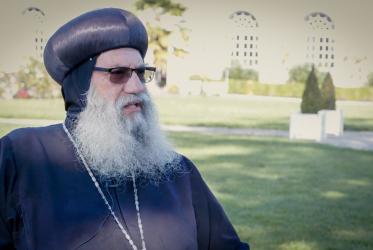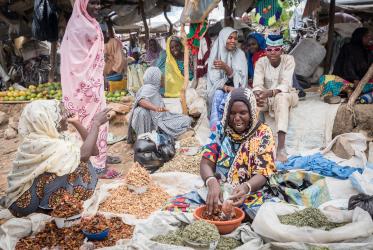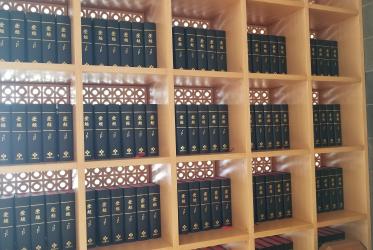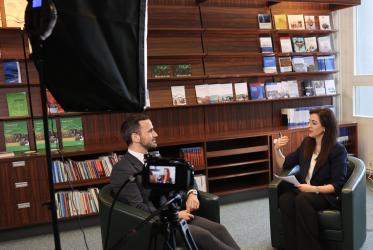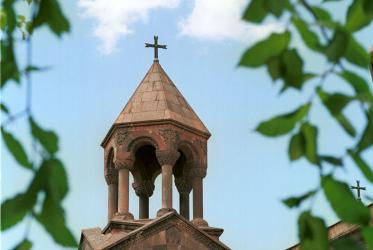SUMMARY OF THE INTERNATIONAL THEOLOGICAL SYMPOSIUM
An International Theological Symposium was jointly organized by WCC-Just and Inclusive Communities, SCEPTRE, NCCI, Bishop's and Gossner Theological College from 13-16th December, 2011 at SCEPTRE, Shrachi Centre, 74B, A.J.C. Bose Road, Kolkata-16. This symposium was attended by about 32 participants, represented by church leaders, theologians, NGOs, from India, Norway, Taiwan, and Myanmar. The symposium was centered around the theme Theologies for a New Church and New World. This symposium was divided into Dalit and Indigenous (Adivasis & Tribals) groups for special emphasis upon their distinct identities. The Indigenous laid stress upon theme Doing Indigenous Theology in Asia: Towards New Frontiers.
This symposium was held over a period of four days with topics ranging from social, economic, political realities of the Indigenous to biblical and theological possibilities and opening to a new world of just and peaceful world. Some of the important highlights of the four day symposium are as follows:
Highlights of the symposium:
Day One: 13th December 2011:
In Day One, both the Dalits and Indigenous had a joint Inaugural Programme with keynote address delivered by Mr. Gladson Dungdung on the topic Indigenous Peoples, Dalits and Adivasis: Challenges and Contributions to Churches and the Ecumenical Movement. Mr. Gladson set the tone of the symposium by challenging to act upon injustice, atrocities, threats to existence of indigenous and rich oriented economic policies. Dr. B.R. Nongbri delivered the inaugural message.
Day Two: 14th December 2011:
The first presentation was on Development and Survival of Indigenous Peoples by Bishop A.S. Hemrom. He emphasized on poverty as one of the issues that strangle development among the indigenous. Alienation of land and cultural exploitation has a lasting impact upon the indigenous that blunt their psychological, social, economic standing in the society.
The second presentation was on The Land, Development and Tribal People by Dr. Wati Longchar. It was pointed out that the Tibals and Adivasis all over the world face similar kind of situation that threatens their very essence of survival. The land, which determines an identity to the Tribals and Adivasis, is the main bone of contention between the indigenous and the government.
The third presentation was on Development of Indigenous Theology: An Appraisal by Dr. Akala Imchen. She started off with the question of Tribal Theology and Tribal Christian Theology. She mentioned that Tribal Theology can be defined as that theology which is contextual and liberative. These two aspects must form its core and scope. It is contextual because it takes to reclaim and integrate the tribal rich heritage in the reformulation of Christian theology in tribal land and by the tribal Christian people. It is liberative because its objective and principle of doing theology is liberation of the people in total dimensions. She further emphasized that the relationship between gospel and culture needs to be thoroughly defined. She found that some theologians on the one hand held to a hierarchal view of Christianity over tribal heritage and on the other, the two as being at par.
The fourth presentation was on Identity Issues and Indigenous Theology by Dr. Yangkahao Vashum. He uses post-colonial method of study as a tool to understand the complexity of the identity of the Nagas subjectively. This critical method provides a clear facilitation to understand the post colonial identity or the hybridized identity of the Nagas as a by-product of colonial era.
While dealing at length the role and effect of colonialism in some of the countries, he saw similarities of identity crisis with that of the Nagas. He also saw problems that are unique to Nagas themselves.
Day Three: 15th December 2011:
The first presentation was on The Uniqueness of Indigenous Spirituality: Adivasi Perspective by Rev. Ekka Manmasih. The paper laid emphasis on two aspects Taxonomy of Culture, Spirituality and Religion and the Liberative Spirituality of the Indigenous. Attempt is made in the first part to clarify the intricacies of the relation as well as the distinction between religion, culture and spirituality. He identified important elements in indigenous spirituality such as dependence in the power of the Spirit, commitment to justice, community centeredness, dependency on land, forest and water, anti-greed attitude, human-nature continuum, equality between man and women.
The second presentation was on Indigenous Theology in Dialogue with Asian Theology by Dr. Lalnghakthuami. She states that there are commonalities and differences in the issues and problems dealt by both Indigenous and Asian Theologies. She is of the opinion that the indigenous theology has their roots in experience of the people which makes it meaningful for a living, challenging and vibrating community. She introduces 'danceas a metaphor for Jesus. She believes that Mizo women experience the presence of Jesus while dancing and in the process, shares the joy and sufferings of Mizo women.
The third presentation was on the Sources and Authority of Indigenous Theology by Dr. Limatula Longkumer. For the Indigenous, sources can be drawn from Oral Tradition, Myths and Stories, Land-centered culture, and Rites and Ceremonies. She laid emphasis on the urgent need of contextualizing the gospel for authentic interpretation of the texts. Indigenous as communitarians lays the foundations for enrichment and growth of the Indigenous Christians.
The fourth presentation was on the Indigenous Theology and Authority of the Bible by Ms. Kirsti Guvsam. Meaningfully, she brought out the Laestadier theology which is in line with liberation theology. Metaphors and letters are used as interesting tools of doing theology.
Day Four: 16th December 2011:
The first presentation was on Development of Indigenous Theology in Taiwan by Rev. Walis Ukan. He identifies the presence of alien political authorities in Taiwan as one of the causes of suffering to the Taiwanese people, both politically and culturally. Therefore the urgency for a people's hermeneutics regarding people as the locus to interpret the meaning of the Bible is clearly indicated by the presenter. It is through reinterpretation of the stories of the Bible in relation to Taiwanese stories and re-telling the Taiwanese Indigenes stories in relation to Biblical stories, the dignity and self autonomy can be restored. It is the interpretation that connects people's experience as the locus of theology and hermeneutics go beyond theory. It becomes living as it develops out of the experience of those people living in fear, deprivation and uncertainty.
The second presentation was on Indigenous Theology Amidst Multi-Faith Context by Dr. Samuel N. Ling. He brought out the Historical, Religious and Theological dimensions of Indigenous Theology. The positive contributions of Missionaries were highlighted but the methods employed by them had negative effect upon the converts. Christians found it difficult to understand God in their context.
The third presentation was on Divergent and Commonalities of Indigenous Theology and Dalit Theology: In Search of Common Ideology by Rev. Bharat Patta. He tried to look at Palestinian struggle with that of Indigenous and Dalits. He found the common threads of suffering under the colonizers, hatred and violence and losing of lands and natural resources. Justice and Peace contradicts the flimsy whims of the perpetrators that destroy the very essence of human existence.
The fourth presentation was a Panel talk on Future of Dalit and Indigenous Theology in Asia by Dr. Samuel Ngun Ling, Mr. Stein Erik Anti, Dr. Joseph Prabhakar, Dr. Lalnghakthuami and Dr. Deenabandhu Manchala.
Dr. Samuel Ngun Ling stressed upon the principle of doing theology in Asia by critically reassign the today's Asia-Global-Local-Indigenous contexts. Asian theologians are challenged to involve in Wider Ecumenism as the Asian culture and religion are diverse.
Mr. Stein Erik Anti stressed at the need for a shift from Coptic Christianity to an Indigenous Sami Christianity. At the moment, a takeover of the Church by the Sami youths is utterly necessary.
Dr. Joseph Prabhakar stressed on dismantling the claims of Classical Theology and establishes Indigenous Theology. Post Contextual Theology is ecumenical and the Indigenous Theology must reinvent as the Theology of Life.
Dr. Lalnghakthuami challenged the Indigenous to name ourselves and to stand under a common umbrella to withstand the divisive, derogatory, and demeaning forces. It is important to make Indigenous Theology intelligible to our congregation.
Closing Remarks:
Bishop Geevarghese Mor Coorilos: He made a critical remark on the Holiness of the Church which is the fundamental tenet of the Universal Church. Yet, the church is not able to witness the true nature of human communion that is exhibited in the Holy Trinity. Today, Ecclesiology is challenged by the threats to the existence of Indigenous. We are challenged to make a shift in our attitude to uphold holy and communitarian life.
Key Issues Debated in the Symposium:
· For the survival of the Indigenous, it is vital to possess the land and reclaim the occupied land from the perpetrators.
· It is important to give legal protection for the preservation of the Indigenous land, which is randomly exploited by gigantic companies that destroys the nature to the fullest.
· Indigenous have the capacity to promote a new spirituality which will enhance human life that believes in mutual living, mutual respect and sharing of human ethos.
· Tribal Theology has the potential to redefine, reclaim cultural and religious elements for the weaker section of the society.
· While constructing Tribal Theology, one should go beyond the metaphorical language and concepts. Perhaps, one can begin from the concept of land.
· The inconsistency in the nomenclature such as; Tribal Theology and Tribal Christian Theology was raised. It was suggested that the difference between the two can be solved by emphasizing on Spirituality of the Indigenous.
· The customary laws deny tribal women to inherit land. Moreover, there are other rights of women which must be addressed in Tribal Theology to make it holistic.
· It was pointed out that the tribal theology must address hierarchical structures that are inherent within the tribal society. Tribal Theology has potential to challenge these oppressive forces and transform the community.
· Attempts should be made to explore more of traditional resources to strengthen the Tribal beliefs, practices, and customs from religious point of view. However, in doing Tribal Theology, we should share the openness in thought and that the same resources must be subjected to critical analysis and reformulation before they be reclaimed and integrated.
· The tribals have suffered from multiple identity crises such as ethnic, cultural, religious, social and political. Thus, one cannot escape from the hybredity in the present the post colonial period. Tribal culture is still the basis and yet, we make daily negotiations with new culture the present context.
· Indigenous Spirituality lays its foundation in vital components such as the working and guidance of the Holy Spirit, sincerity to justice and peace, community oriented, human-nature continuum, equality between man and women and sharing community.
· The spirituality of indigenous people is liberative. Thus, the dichotomic typologies of plenum and axial, mystic and prophetic, contemplative and liberative must be overcome for a holistic understanding of spirituality.
· While dealing with Indigenous Spirituality use liberative language instead of derogatory and oppressive language that demeans the Indigenous community. Using the term Tribal/Adivasi can be liberative and life affirming.
· In doing Indigenous Theology we can use 'dance' as a metaphor for Jesus as the dancer. One can experience the presence of Jesus while dancing and share the joy and sufferings of Mizo women in this process. Mizo women can find themselves empowered by the presence of Jesus through the expression of dance.
· 'Jesus as a dancer' can be one of the spiritualities of women. Dances that are patriarchically constructed must be avoided. Rather, it should be liberative and related to the soil.
· While formulating and interpreting Asian texts, the interpretation of the elders, who are often out of the church, must be invited for comprehensive translation of the Bible. There is a disconnect between the congregation and the elders in the Taiwanese context.
· Stories and myths that are degrading to the women must be avoided in the theological formulation. Rather, songs, poems, folktales that provide liberative perspective to the women must be used.
· Bible is a book for the Indigenous too. But the Bible is in the captivity of the dominant which must be liberated. For instance, Tsungrem is in neuter gender. However, the missionaries placed Tsungrem in masculine which reflects the patriarchal mindset of the then missionaries.
· In doing theology one can use letters as a source. In Norway, Lars Levi Laestadius used letters for the liberation of his people.
· In the context of Taiwan, the development and construction of Taiwanese Indigenous Theology can rebuild the dignity, self autonomy of the indigenes, besides the continuation of traditional culture and restoration of the land ownership.
· Theology formulation in Taiwan is for both the Christians and people of other faiths. Theology in Taiwan is of people's movement. Indigenous and Indigenous scholars join hand in formulating relevant people centered theology. It is a movement of human rights, a movement to protect land.
· In doing Indigenous Theology one should stick to culture. For instance, there is a great cultural divide between men and women in Myanmar. Educated women find it difficult to locate themselves. Women empowerment is needed in Myanmar, especially Baptist women.
· In doing Indigenous Theology, academy, church and world must intersect. Perhaps, an interdisciplinary hermeneutics is necessary as Asia cradles multiple identities of the Indigenous.
· Indigenous Theology must reinvent itself in order to reach the people in the grass root level. The gap between the church and common people is wide and the church leaders are represented by men. This calls for dismantling the power of the dominant and accommodate the weaker section for a just and loving church.
· Indigenous Theology must challenge the neo-context of globalization that exploit the poor economically.
· Thus, Indigenous Theology must attempt to seek new possibilities and take it to the global level. Indigenous Theology must come alive in the lives of the people, or church and become church of the people.
· In doing Indigenous Theology, the idea of Holiness of God must be stressed in the church. Church has failed to practice holiness, a prerequisite of communitarian living, and divided the congregation in the line of caste, gender and ethnicity.
· In addition, we need to bring back Jesus' vision of holiness in terms of being different and counter culture. The genius of Indian church must be dalitness and tribalness. In doing so, we will do a great service in formulating Indian ecclesiology.
Recorded by:
K. Dhanbir Rai & Moanungsang Tzudir
